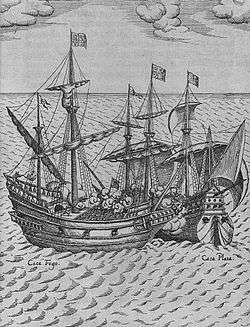Nuestra Señora de la Concepción
 Capture Of Cacafuego (1626) engraving by Friedrich Hulsius | |
| History | |
|---|---|
| Name: | Nuestra Señora de la Concepción |
| Nickname(s): | Cacafuego |
| General characteristics | |
| Type: | Galleon |
| Tons burthen: | 120 tons (bm) |
| Propulsion: | Sails |
Nuestra Señora de la Concepción (Spanish: "Our Lady of the (Immaculate) Conception") was a 120-ton Spanish galleon that sailed the Peru - Panama trading route during the 16th century. This ship has earned a place in maritime history not only by virtue of being Sir Francis Drake's most famous prize, but also because of her colourful nickname, Cacafuego ("fireshitter").[1]
Capture by Sir Francis Drake
At the helm of his ship Golden Hind, Sir Francis Drake had slipped into the Pacific Ocean via the strait of Magellan in 1578 without the knowledge of the Spanish authorities in South America. Privateers and pirates were common during the 16th century throughout the Spanish Main but were unheard of in the Pacific. Accordingly, the South American settlements were not prepared for the attack of "el Draque" (Spanish pronunciation of Sir Francis' last name), as Drake was to be known to his Spanish victims. During this trip, Drake pillaged El Callao (Peru's main port) and was able to gather information regarding the treasure ship Cacafuego, which was sailing toward Panama laden with silver and jewels.[1]
Golden Hind caught up with Cacafuego on 1 March 1579, in the vicinity of Esmeraldas, Ecuador. Since it was the middle of the day and Drake did not want to arouse suspicions by reducing sails, he trailed some wine caskets behind Golden Hind to slow her progress and allow enough time for night to fall. In the early evening, after disguising Golden Hind as a merchantman, Drake finally came alongside his target and, when the Spanish captain San Juan de Antón refused to surrender, opened fire.[1]
Golden Hind's first broadside took off Cacafuego's mizzenmast. When the English sailors opened fire with muskets and crossbows, Golden Hind came alongside with a boarding party. Since they were not expecting English ships to be in the Pacific, Cacafuego's crew was taken completely by surprise and surrendered quickly and without much resistance. Once in control of the galleon, Drake brought both ships to a secluded stretch of coastline and over the course of the next six days unloaded the treasure.[2]
Drake was pleased at his good luck in capturing the galleon, and he showed it by dining with Cacafuego's officers and gentleman passengers. He offloaded his captives a short time later, and gave each one gifts appropriate to their rank, as well as a letter of safe conduct.[2] Laden with the treasure from Cacafuego, Golden Hind continued its voyage westward, completing the second circumnavigation of the earth by returning to Plymouth, England, on 26 September 1580.[3]
Cacafuego v. Cagafuego
Despite her very proper name, the galleon Nuestra Señora de la Concepción was called by her sailors Cacafuego, which would translate into English as "fireshitter" (similar concept as Spitfire).
In modern Spanish the name would be "Cagafuego", where the verb is "cagar" (defecate). This verb comes from Latin "cacare" with the same meaning, defecate,[4] which evolved to "cacar", as it was in the 17th century, and from the verb evolved the noun "caca".[5] More recently "cacar" evolved to "cagar" in modern Spanish.
References
Citations
- 1 2 3 Coote, p.156
- 1 2 Coote, p.157
- ↑ Coote, p.182
- ↑ http://lema.rae.es/drae/?val=cagar
- ↑ http://lema.rae.es/drae/?val=caca
Sources
- Coote, Stephen (2003). Drake: The Life and Legend of an Elizabethan Hero. New York: Thomas Dunne Books. ISBN 0-312-34165-2.
- Cordingly, David (1995). Under the Black Flag: The Romance and the Reality of Life Among the Pirates. New York: Random House. ISBN 0-15-600549-2.
- Williams, Neville (1975). The Sea Dogs: Privateers, Plunder and Piracy in the Elizabethan Age. London.